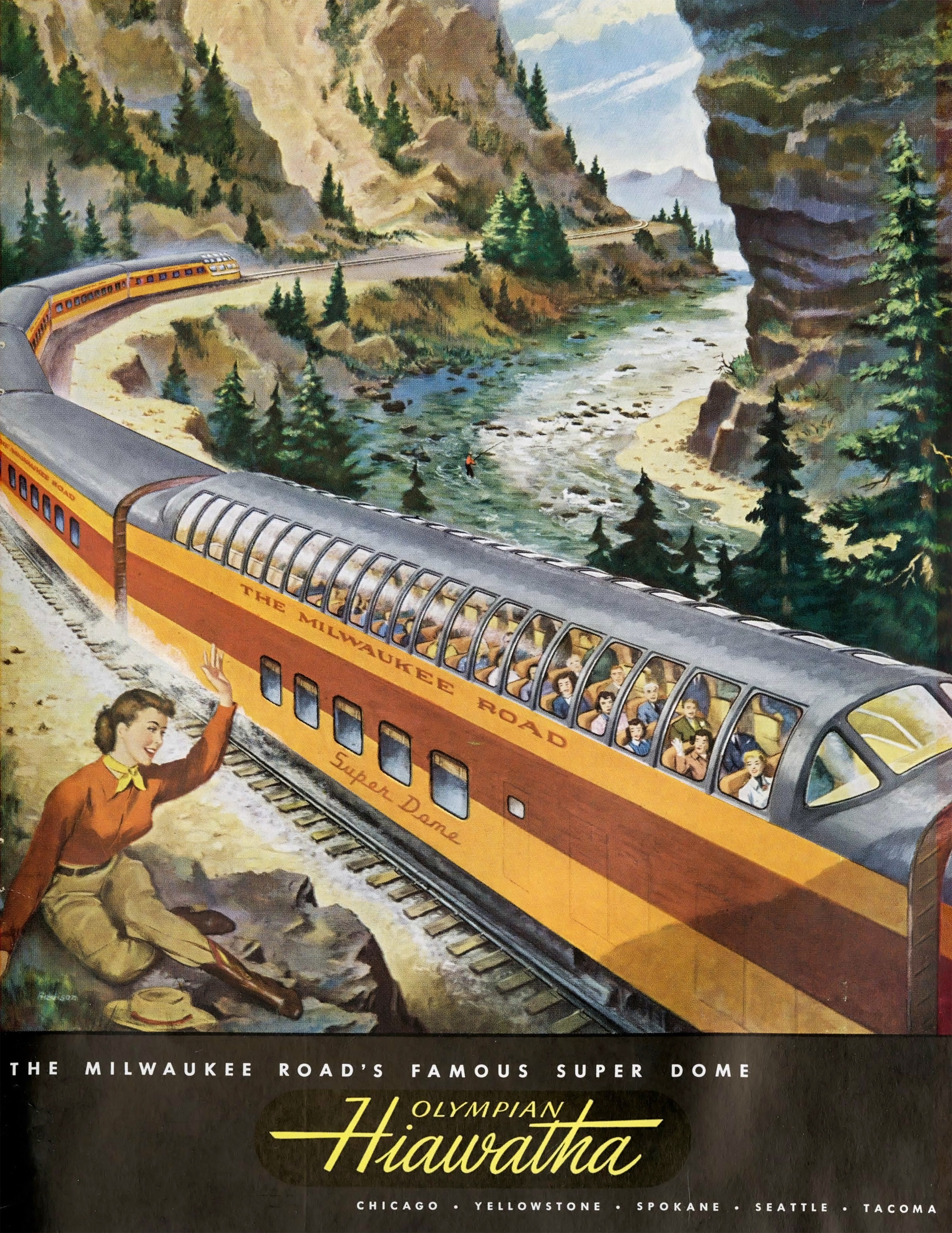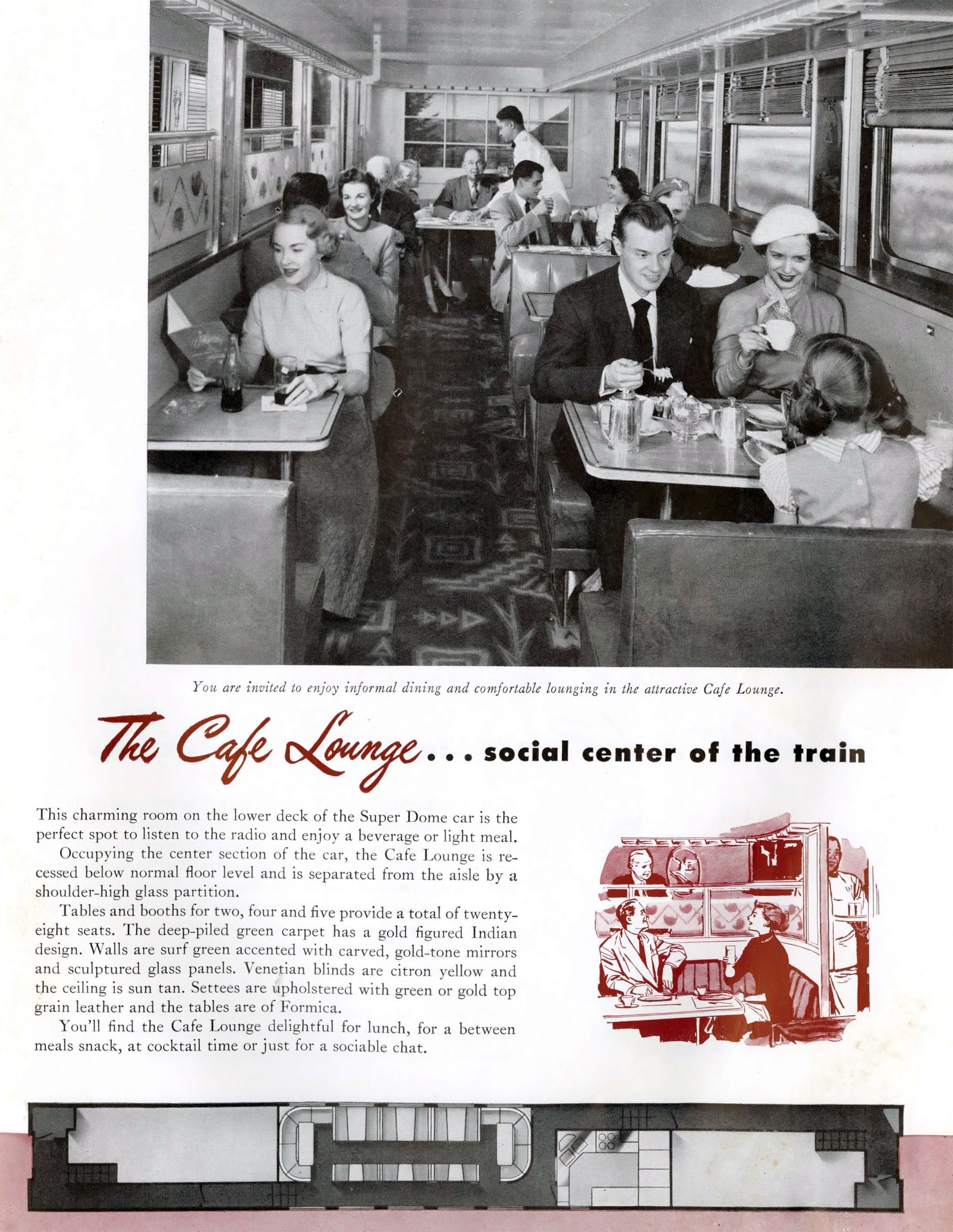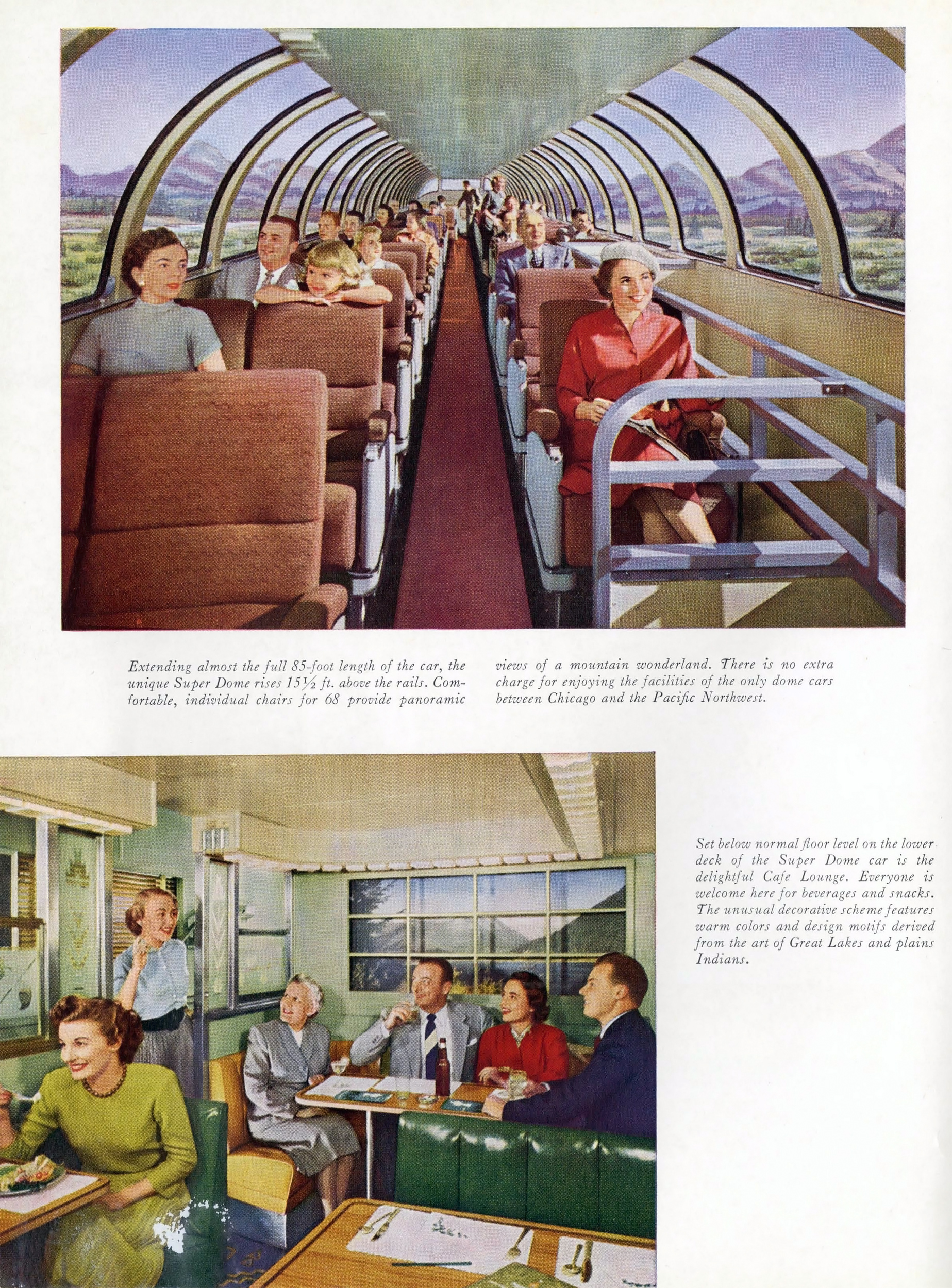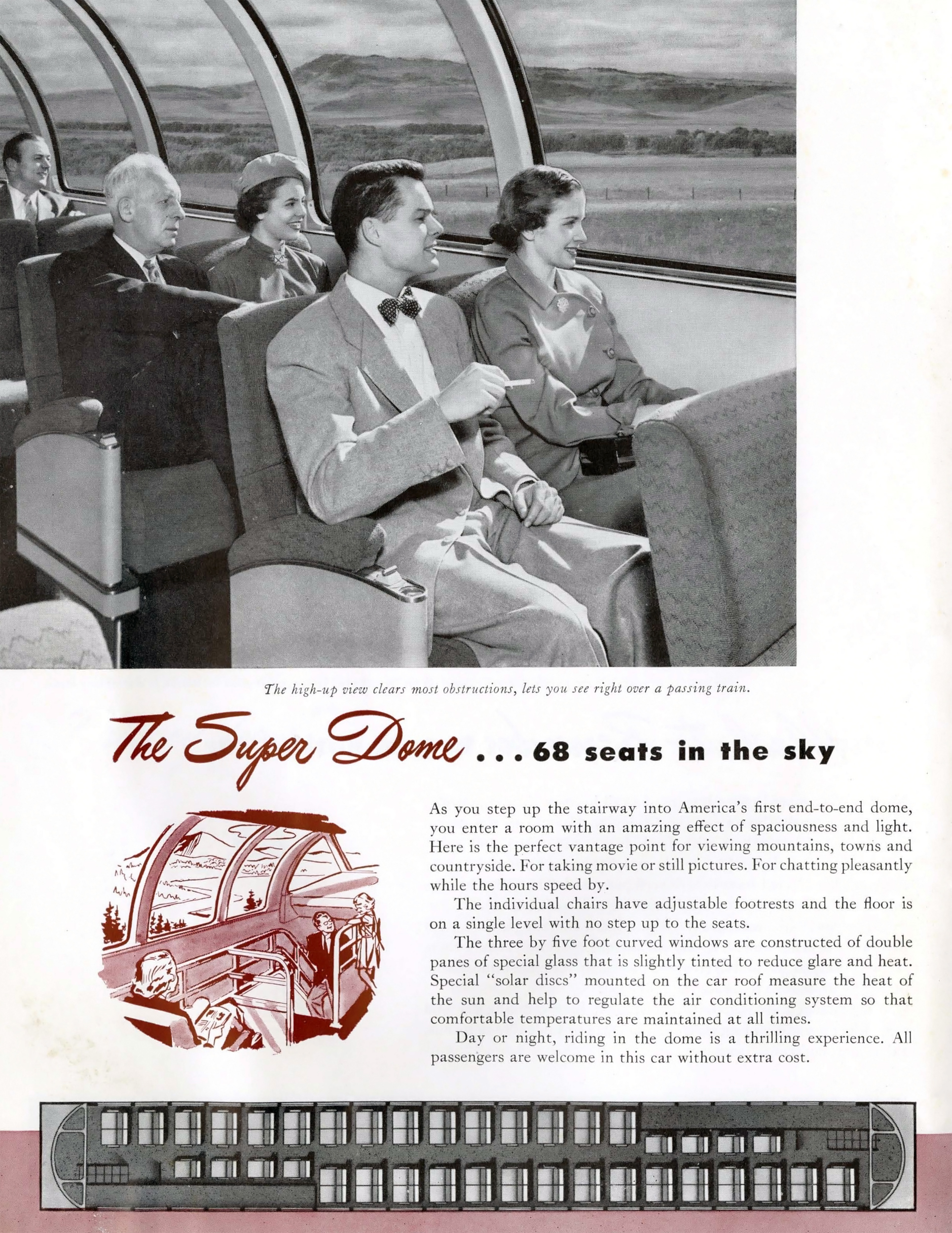Super Dome (Railcar): History, Photos, Preservation
Published: February 6, 2025
By: Adam Burns
The Milwaukee Road's "Super Domes" were exotic for their time as the first full length domes to operate on an American railroad when they entered service in 1952.
In conjunction with Pullman-Standard the railroad had ten such cars built for its transcontinental Olympian Hiawatha . The Super Dome expanded upon the mid-car raised solariums pioneered by the Vista-Dome of the mid-1940s.
When first introduced they represented not only a pinnacle of luxury but also an emblematic shift in the competitive landscape of passenger rail service.
With an eye towards both innovation and customer satisfaction, the Milwaukee Road embarked on a journey to redefine the passenger experience, a journey that is still admired by rail enthusiasts and historians today.
When the railroad canceled the Olympian Hiawatha in 1961 the cars were sold to the Canadian National for service on the Super Continental. Four cars were later purchased by Amtrak on various western trains, as well as the Auto Train.
Design
The introduction of the Super Domes was a strategic move to enhance the appeal of the Milwaukee Road's "Hiawatha" services, both the regional runs to the Twin Cities as well as the railroad's transcontinental service to Seattle/Tacoma.
By the 1940s and 1950s, the allure of rail travel had begun to wane with the advent of more accessible airlines and the burgeoning interstate highway system.
Railroads were thus compelled to innovate both technologically and experientially to retain and attract passengers. The Milwaukee Road, known for its progressive thinking, responded with the creation of the Super Domes in conjunction with Pullman-Standard which had been experimenting with a full-length dome car in the postwar era.
Numbered 50-59, the cars were a marvel of engineering and design. The name originated from an employee naming contest, with alternative proposed names such as Master Dome, Ultra Dome, and Panorama Dome being rejected. The cars were deployed on the daytime Twin Cities Hiawatha and the transcontinental Olympian Hiawatha routes.
Notably, the Super Domes were the sole cars on a daytime Hiawatha route constructed by an external entity; all other Hiawatha equipment, including the distinctive Beaver Tail and Skytop lounges, were constructed in-house at the Milwaukee Shops.
Specifications
Dome cars in general were an architectural marvel that consisted of glass panes arranged in a sleek, aerodynamic configuration, offering unrivaled panoramic views of the surrounding countryside. These vistas were critical to the appeal of the Super Domes, transforming every journey into an immersive travel experience.
Amenities such as air conditioning, reduced noise, and innovative suspension systems further elevated the travel experience, establishing a standard for comfort that significantly enhanced the Milwaukee Road’s appeal.
Each Super Dome was constructed at a cost of $320,000, an exorbitant sum for its era. Designed with upper-level seating for 68 passengers, the Super Dome's capacity was nearly triple that of the conventional dome cars employed by other railways.
The dome level was supplemented by a lower level that included a comfortable lounge area with 28 seats and Milwaukee's trademark Tap Room bar, creating a social hub where passengers could congregate and enjoy the finer points of their journey.
Each car measured 85 feet in length, 10 feet in width, and stood at 15 feet, 6 inches in height. The body alone weighed in at 134,050 pounds, while each of its six-wheel trucks accounted for 66,550 pounds. When fully operational and loaded with passengers, these cars reached an approximate total weight of 224,080 pounds.
The Super Domes came equipped with a self-contained diesel power plant that provided heating and lighting independent of the main train system.
This included two Waukesha diesel Enginator generators. Inspired by Milwaukee’s innovation, other railroads such as Great Northern and Santa Fe also commissioned full-length domes similar to Milwaukee’s. In contrast, Southern Pacific opted for domes with open galleries offering seating on a lower tier.
Operational Issues
However, the Super Domes did not achieve complete success within the Milwaukee Road's service. Due to their heavy weight, they provided a rather unsteady ride.
In addition, the full-length dome design did not afford passengers clear forward and rear views, a feature that had been readily available in the 24-seat dome cars, thereby compromising the full panoramic experience.
Nonetheless, the distinction of being the first full-length dome car conferred significant promotional value on the railroad and the Milwaukee heavily promoted its new cars.
Following the discontinuation of the Olympian Hiawatha in 1961, the Super Domes appeared on the joint Milwaukee/Union Pacific City of Denver for one summer.
In 1964, the Milwaukee sold six of the domes to the Canadian National, along with the sleeper-lounge Skytop Lounges. The remaining four domes remained in operation on the Twin Cities Hiawatha route.
Legacy
The Super Domes weren't just a radical departure from the utilitarian train coaches of the early 20th century; they represented a new vision of rail travel where comfort, luxury, and innovation intersected.
The Milwaukee Road’s venture into dome cars was both a technological and experiential revolution, a bold statement in a time of transition that, even today, serves as a reminder of the indelible mark left by rail travel on the cultural landscape.
As history looks fondly back at these splendid railcars, they remain an embodiment of a cherished epoch in railroad history, symbolizing the zenith of rail-based luxury and the enduring quest to connect people, places, and the unfolding spectacle of nature’s panoramas.
Preservation
Numerous Super Domes continue to operate, predominantly on heritage railways. Of note is car #52, which, after serving the Milwaukee Road, Canadian National, VIA Rail, and various private operators for many years, has been incorporated into the Napa Valley Wine Train since 1995.
In addition, #53 typically runs attached to the Milwaukee Road 4-8-4 #261 operated by the Friends of the 261. Finally #55 and #59 now operate on the Reading & Northern as #4 and #5. Lastly, Canadian National maintains one in active service within their executive train fleet.
Recent Articles
-
California Christmas Train Rides In Felton!
Nov 25, 25 12:48 PM
The Santa Cruz Holiday Lights Train offers a dazzling nighttime experience that transforms downtown Santa Cruz into a rolling festival of lights, music, and holiday spirit. -
Alabama Christmas Train Rides In Calera!
Nov 25, 25 11:45 AM
If you’re considering a holiday outing that blends nostalgia, sparkle, and simple together time, the Heart of Dixie’s Christmas trains are hard to beat. -
Wisconsin Christmas Train Rides In East Troy!
Nov 25, 25 11:39 AM
When the holidays arrive, the museum becomes a festive favorite thanks to its Christmas Trains, a family tradition that pairs small-town warmth with the magic of an old-fashioned trolley ride.







